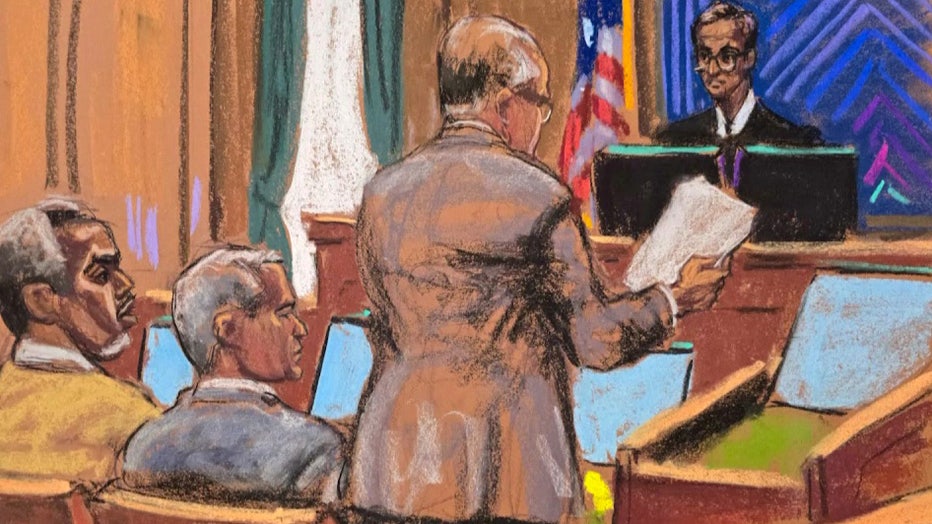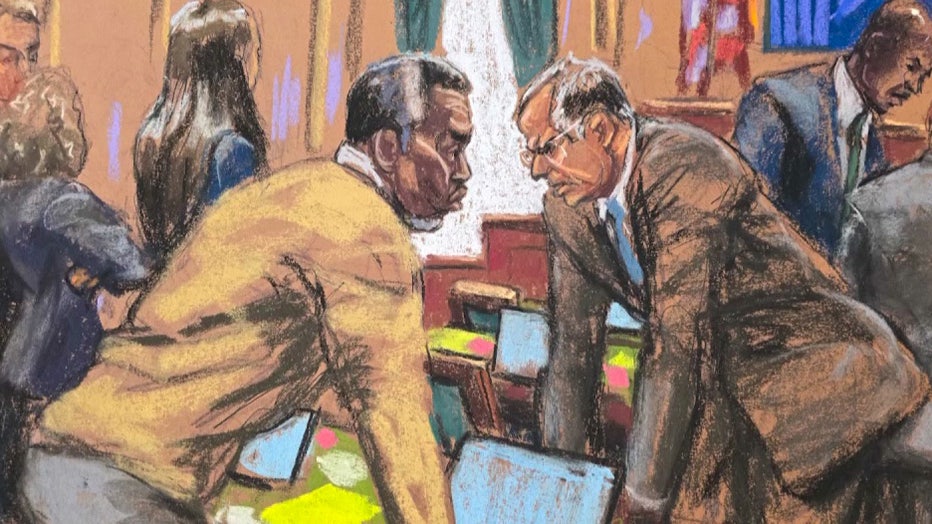Jury reaches partial verdict in Diddy trial; undecided on top count
NEW YORK - The jury returned to deliberate for a second day on Tuesday at the sex trafficking trial of Sean "Diddy" Combs and ended up closer to a verdict – sort of.
Tuesday afternoon, the jury reached a verdict on counts 2, 3, 4, and 5, but was split on count 1, with the defense urging them to continue deliberating rather than deliver a partial verdict.
Diddy's defense team asked the court not to rush the jury, emphasizing that jurors were working efficiently through a large volume of material. Instead, attorneys advocated re-reading portions of the jury instructions and pushed back on any effort to pressure jurors, including the possibility of invoking an Allen charge.
Court ended at 5:20 p.m. and will resume Wednesday at 9 a.m.

Jury reaches partial verdict in Diddy trial
Jurors have reached verdicts on some, but not all, of the counts against Sean "Diddy" Combs.
What is Count 1 Racketeering Conspiracy?
In Count One, prosecutors allege Diddy participated in a racketeering conspiracy from at least 2004 through 2024. During this time, he conspired with employees and associates of his businesses to commit kidnapping, arson, bribery of a witness, obstruction of justice, drug distribution, forced labor, sex trafficking, and transportation for purposes of engaging in prostitution.
What is an Allen Charge?
An Allen charge, also called a "dynamite" or "shotgun charge," is a special instruction a judge gives to a jury that can’t agree on a verdict (Legal Information Institute).
It encourages jurors to keep deliberating and try to reach a unanimous decision. These charges are controversial because some believe they put too much pressure on jurors, especially those in the minority, to change their opinions. For this reason, many states ban Allen charges, but they are still allowed in federal courts.
The term "Allen charge" comes from the 1896 Supreme Court case Allen v. United States, which approved their use in federal cases.
What happens in a hung jury?
A hung jury happens when jurors can’t agree on a verdict, which could lead to a retrial (Legal Information Institute).
Hung jury NY law
In New York, a unanimous decision is required to avoid a hung jury.
If the jury remains deadlocked on any of the charges, the judge could declare a mistrial.
A mistrial does not mean that the case is over according to NY law. The prosecutor can decide to retry Penny if a mistrial is declared.
Diddy trial live updates
Live updates from inside and outside the courtroom will be posted here once they are available. You can also watch our YouTube player below for realtime alerts.
- 4:36 p.m.: The jury has reached a verdict on counts 2, 3, 4, and 5, but remains deadlocked on count 1, with the defense urging them to continue deliberating rather than deliver a partial verdict.
- 4:26 p.m.: Diddy's entire defense team is standing huddled over him as he sits in a chair at the defense table.
- 4:21 p.m.: A marshal handed an envelope to the judge’s deputy, who then told Diddy’s lawyer, Marc Agnifilo, to assemble his team. Agnifilo had walked into the courtroom a few minutes earlier, joined by several defense lawyers, while none of the prosecutors have returned yet.
- 4:18 p.m.: A new juror note was received.
- 11:22 a.m.: The jury wants to hear Casandra "Cassie" Ventura's testimony regarding the Intercontinental Hotel, Cannes and freak offs with Daniel Philip. The jury also wants testimony from Daniel Philip regarding Cassie Ventura. The jury will not be brought out until an agreement has been reached on all the aforementioned testimonies.
- 10:28 a.m.: The jury has sent another note, but the judge is waiting for all parties to return to the courtroom.
What happened on Monday?
What we know:
Jurors deliberated for over five hours without reaching a verdict after receiving instructions on the law from the trial judge, Arun Subramanian. They are deciding whether prosecutors have proven racketeering conspiracy and sex trafficking charges during a trial that began in early May.
When jurors first left the room to begin deliberating, Combs sat for a while slumped in his chair at the defense table before standing and turning toward three rows of spectators packed with his family and friends.
Those supporters held hands and lowered their heads in prayer, as did Combs, who was several feet from them in the well of the courtroom. After they finished, they together applauded, and so did Combs, still clapping as he turned back toward the front of the room.
Combs also showed off two books he’s reading: "The Power of Positive Thinking" by Norman Vincent Peale and "The Happiness Advantage" by Shawn Achor.

Diddy trial: Day one of jury deliberations end
Monday was the first day of jury deliberations for the Sean 'Diddy' Combs trial. As 5 hours of deliberation concludes, LiveNOW's Andy Mac is joined by TMZ's Michael Babcock to talk about the recent updates.
Barely an hour into deliberations, the jury foreperson sent a note to the judge, complaining that there was one juror "who we are concerned cannot follow your Honor’s instructions. May I please speak with your Honor or may you please interview him?"
The judge decided instead to send jurors a note reminding them of their duties to deliberate and obligation to follow his instructions on the law.
By day's end, the jury seemed back on track, requesting clarification about what qualifies as drug distribution, an aspect of the racketeering conspiracy charge that will help determine whether Combs can be convicted or exonerated on the count.

Jane Rosenburg courtroom sketch
What was Diddy charged with? What are the accusations?
The backstory:
Diddy, 55, has pleaded not guilty to federal charges of racketeering conspiracy, two counts of sex trafficking — relating to ex-girlfriends Cassie and "Jane" — and two counts of transportation to engage in prostitution for allegedly arranging to fly sex workers across state lines.
Dig deeper:
He faces three charges, with five counts. Here's a closer look:
Count 1: Racketeering Conspiracy.
- Count One charges that, from at least in or about 2004 through in or about 2024, the defendant participated in a racketeering conspiracy during which he agreed with other employees and associates of his businesses to commit kidnapping, arson, bribery of a witness, obstruction of justice, drug distribution, forced labor, sex trafficking, and transportation for purposes of engaging in prostitution.
Count 2: Sex Trafficking by Force, Fraud, or Coercion.
- Count Two charges the defendant with sex trafficking an adult female victim through force, fraud, and coercion between ~2009 and ~2018.
Count 3: Transportation to Engage in Prostitution.
- Count Three charges the defendant with transporting that female victim and male commercial sex workers to engage in prostitution between ~2009 and ~2018.
Count 4: Sex trafficking.
- Count Four charges the defendant with sex trafficking a second adult female victim through force, fraud, and coercion between ~2021 and ~2024.
Count 5: Transportation to Engage in Prostitution.
- Count Five charges the defendant with transporting that second female victim and male commercial sex workers to engage in prostitution between ~2021 and ~2024.
What happened during the trial?

Jane Rosenburg courtroom sketch
Timeline:
The trial began with a video showing Combs attacking his girlfriend Cassie, setting the stage for seven weeks of testimonies from 34 witnesses, including Cassie and another ex-girlfriend, Jane, who accused Combs of violent and abusive behavior.
Cassie and Jane detailed instances of physical abuse and coercion into sexual activities, with Cassie describing "freak-offs" and Jane recounting feeling pressured due to financial dependency. Both women claimed Combs threatened to release sex videos if they didn't comply.
Other witnesses, including rapper Kid Cudi and former employees, testified about Combs' violent behavior and threats, with accusations ranging from sexual assault to intimidation and property damage.
Combs' defense focused on discrediting the prosecution's witnesses, highlighting inconsistencies in their accounts and their continued interactions with Combs post-abuse. The defense did not call any witnesses and Combs chose not to testify.
Originally, prosecutors built their case around four main witnesses: Cassie, Jane, Mia and Gina. Gina was dropped from the case, though they were mentioned during the trial. The defense leveraged the absence of these testimonies to question the prosecution's narrative.
The Source: This article includes information from the Associated Press, analysis from FOX 5 NY reporters and excerpts from Diddy's indictment.

